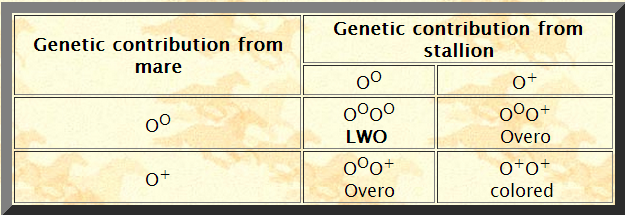Search The Horse Genetics Website (opens in a new tab)
Lethal White Overo (OWLS)
Homozygous overo horses (OoOo) are born are all-white with blue eyes. Sadly they soon die of complications from intestinal tract abnormalities. Both melanocytes (pigment cells) and ganglia (nerve cells) are migratory cells that originate from the same area of the developing foetus known as the neural crest. The all-white foals lack both pigmentation and nerve cells in the intestinal tract (aganglionosis). When two heterozygote overo horses are bred together an average of 25% of foals will be lethal white overo (LWO). Put another way there’s a one in four chance of a lethal white overo foal. Surviving offspring will be solid colored or heterozygous overo horses.
Matings between solid and overo horses result in solid and overo foals in approximately equal numbers, with no lethal white foals. This is the responsible way of producing overos.
Some suggest that the best way to breed paints is to breed together paint horses with more than one pattern, to increase the odds of paint foals. However this can hide overo, thereby increasing the risks of unknowingly producing lethal white overo foals, either immediately or in the future, and generally promoting confusion about its inheritance.
Occasionally horses without noticeable body spotting patterns have sired or produced lethal white foals, including quarter horses. The overo spotting pattern is phenotypically heterogeneous and minimally marked horses may show insufficient pattern to be identified as overo horses, even though they have the overo genotype.

Lethal White Overo Testing
Breeders would obviously like to be able to recognize horses at risk of producing lethal white overo foals. Until recently, there has been no reliable way to identify which horses have the gene associated with lethal white overo.
Lethal white overo has been shown to be due to a mis-sense mutation in the endotheline-B receptor gene. This means that the genetic code has been changed in a way that changes the receptor protein produced by the gene. There is only a single nucleotide difference between the wild type and mutant genes, but this is enough to change the protein so that it doesn’t function (nucleotides are the building blocks of DNA).
The mutation occurs in "frame overos" (e.g. in “paints” and “colored” Thoroughbreds), in some pinto mixtures (e.g. tovero) and in some minimally marked overo horses, including some Quarter Horses without obvious evidence of the overo pattern.
The diagnostic test now available to identify breeding horses at risk of producing lethal white foals uses a molecular genetics technique called an allele specific polymerase chain reaction (PCR).
DNA is extracted from either blood, or hair samples with roots. The PCR reaction copies the DNA sequence associated with LWO, a reaction that can only happen in samples containing the sequence (i.e. the LWO mutant gene).
Fluorescent molecules are used for DNA replication and are incorporated into any PCR products. This allows immediate genotyping, with fluorescence indicating a positive result (i.e. mutation present). If the mutation is present this indicates overo, even when this isn’t obvious by looking at the horse.
No other mutations associated with lethal white overo horses are currently known about. However there is a small possibility that two solid colored horses could have a lethal white foal due to the sire and dam having in common a mutation at another site than the one detected by the test. In other animals, e.g. mice, hamsters, dogs, cats and humans, similar disorders to LWO occur due to a wide range of mutations.
Reference
D.L. Metalinos, A.T. Bowling, J. Rine, 1998. A missense mutation in the endotheline-B receptor gene is associated with Lethal White Foal Syndrome: an equine version of Hirschsprung Disease. Mammalian Genome 9, 426-431.
